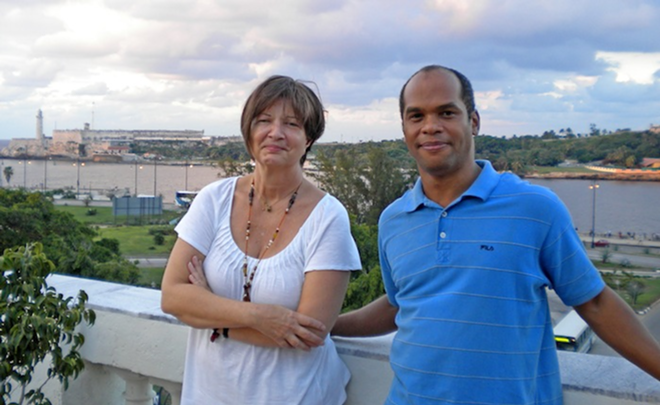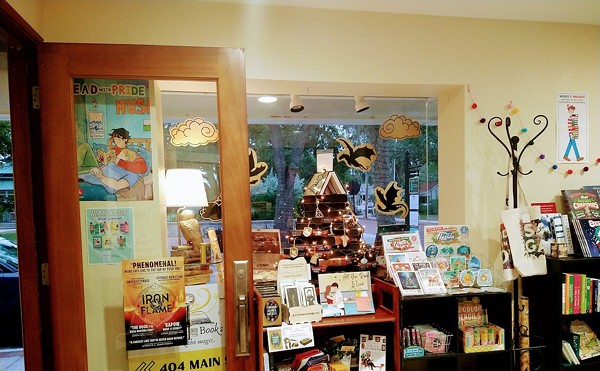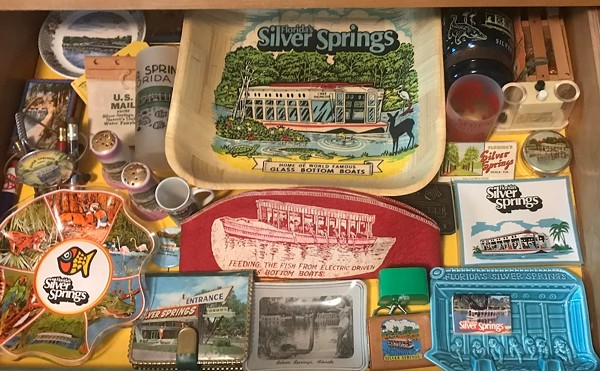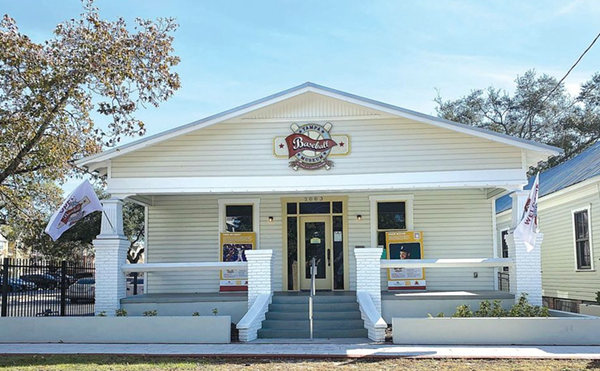Noel Smith has been traveling back and forth to Cuba since 1999. But her connections with the island nation go back much further than that.
“I became a Cuban,” says Smith, “in utero.”
The curator of Latin and Caribbean art at the USF Institute for Research in Art: Contemporary Art Museum and Graphicstudio, Smith is the daughter of Sarah Eagle (née Hale), whose family moved from New Orleans to the Brooksville area in the 1880s. Sarah had two uncles with business in Cuba — Fred Morris partnered with Lykes Steamship in Havana and his brother Julian ranched and grew sugar cane in the eastern part of the island — and the family visited them each year, Sarah learning Spanish and even attending the University of Havana.
“The last time she visited Cuba she was five months pregnant with me,” says Smith. “I didn’t know that the first time I was there in 1999, but the air, the sun, the streets and the smells of the city were somehow familiar to me.”
Uncle Fred’s house is now the headquarters of a Cuban tourist agency — aptly enough, given that hundreds of thousands of Freds are doubtless planning their own Cuban pilgrimages as the barriers to travel decrease.
Smith, 63, made her first visit to Cuba with Graphicstudio director Hank Hine (now director of the Dalí), who wanted to recruit artists like Liset Castillo and Ibrahim Miranda to collaborate on projects at the studio. Working with current IRA Director Margaret Miller, Smith started curating for CAM, including the first major American show by the Los Carpinteros collective in 2005. She has forged a strong relationship with Cuba’s National Museum of Fine Arts and has become a busy translator of monographs, catalog essays, poetry, and mystery novels. She’s even written the libretto for an opera based on the life of Alejandro Garcia Caturla, a composer sometimes known as the Stravinsky of Cuba.
With all of that experience — and after an estimated 20-plus visits to Cuba over the years — she is well-versed in the country’s lasting allure and the challenges it faces. A plaintiff in the ACLU suit against the State of Florida regarding its now-obsolete 2006 law banning travel to “terrorist states,” she looks ahead to a more open, but no less complicated, relationship between Cuba and the U.S., and is already planning her next visit, an event with Los Carpinteros at the Spanish Embassy.
CL: How does your family heritage inform your thinking about Cuba?
NS: I’ve always been kind of a a liberal… people who hated Castro, I’d think, “You guys should try and get over it.” But when I went to Cuba the first time, I thought, “I understand why these people feel that huge sense of displacement and outrage — what they’ve left behind.” I think it’s really in your blood; there’s something so seductive about that island.
What’s changed over the 16 years you’ve visited?
There’s really a kind of foodie movement going on in Cuba, a huge change. Also, the change of people being able to have their own little businesses, and embracing it wholeheartedly. The transportation system still really sucks. The bus system is terrible, the roads are still pretty bad, houses are still falling down, with no paint. But all in all there’s more of a sense of optimism.
What will the relaxation of travel rules mean for you?
Ostensibly faculty and students should be able to access university-funded travel. But it’s still up in the air, so people like me, if you need to go to Cuba, you go anyway.
And for Cuba?
Letting Americans travel down there freely is going to seriously stress tourism and hospitality. A lot of people tell me, “I want to go to Cuba before it changes.” Changes from what? You haven’t been there, so you don’t know. Strangely, I’m hoping that the Cubans do get Starbucks and they do get a Home Depot and they do get decent grocery stores — because right now life is so difficult for them. And Cuba has always been incredibly influenced by the U.S., yet it never lost its flavor. Here’s what I’m hoping for: Because it’s been so isolated, there’s so many areas that haven’t been touched — reefs, beaches, forests, beautiful expanses of land. I don’t care what happens to the city. I just hope the Cubans get to have a better life. But they also deserve to keep that ecological jewel they have.
How have you seen Cuban art develop?
They have done incredible things to promote the arts — artists educated for free, considered workers like everyone else. When the Soviet Union pulled out in 1991, the Cuba economy was suddenly in shambles, and then the Bienal [and the idea of selling work] became really important. Now artists like Los Carpinteros are rock stars in Cuba.
Cuban detective novelist Leonard Padura told the New York Times that artists are always testing the limits in Cuba, but “you never know how far you can go.”
I think you’ll find there’s a lot of political art that’s not overt, but Cubans understand what they’re saying. What’s interesting about the arts scene in general is that the idea of social engagement in the arts is very, very important in Cuba. Education is free and art education is excellent, but you’re always expected to do a two-year stint of public service.
Talk about Cuba's links with Ybor.
I grew up with one foot in Palma Ceia and the other foot in Ybor City. I was the Latin Fiesta queen when I was 16 — at the Tampa Bay History center there’s a huge cutout of me with my crown. That was a thriving community then, with all its little clubs, but even then it was kind of decrepit. For me it’s always going to have a flavor of Cuba. And every Cuban who comes to Tampa must go to Ybor City. They have to go to see the staircase where José Martí was.

















